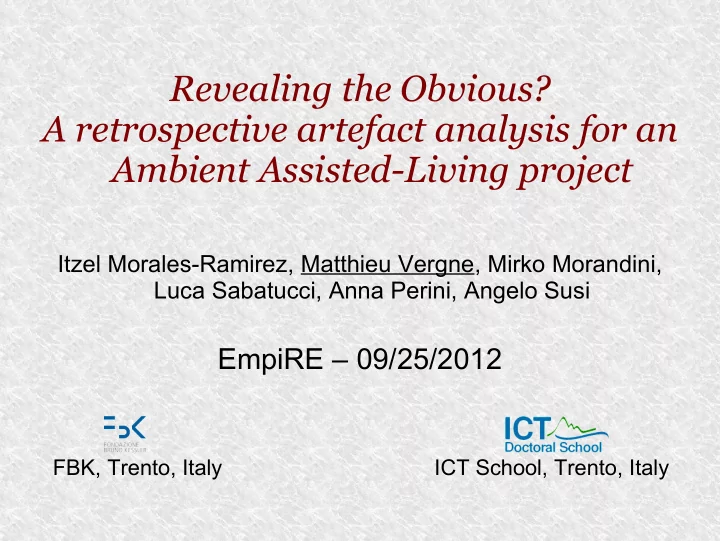

Revealing the Obvious? A retrospective artefact analysis for an Ambient Assisted-Living project Itzel Morales-Ramirez, Matthieu Vergne, Mirko Morandini, Luca Sabatucci, Anna Perini, Angelo Susi EmpiRE – 09/25/2012 FBK, Trento, Italy ICT School, Trento, Italy
Outline ● Context ● Problem ● Study Design & Process ● Results & Threats to Validity ● Conclusion EmpiRE 2012 - 09/25/2012 2/19
Context ● Domain: Complex software systems ● Complex set of requirements ● Ex: Socio-Technical System (STS) ● Focus: Requirements elicitation & analysis ● New system ● System evolution EmpiRE 2012 - 09/25/2012 3/19
What is the problem? We have: – Information sources – Requirements elicitation/modeling techniques – Guidelines to use them But: – Are guidelines followed? Effective? ➔ Practice poorly documented What would be great? – Identify which requirements come from: • which source/technique EmpiRE 2012 - 09/25/2012 4/19
What is a Retrospective Study? Dingsøyr, 2005 [1] “By a postmortem, we mean a collective learning activity which can be organised for projects either when they end a phase or are terminated . The main motivation is to reflect on what happened in the project in order to improve future practise [...] This type of processes has also been referred to as ‘ project retrospectives ’.” Easterbrook & Aranda, 2006 [2]: retrospective EmpiRE 2012 - 09/25/2012 5/19
Why a Retrospective Study? See if practices follow guidelines See if techniques are effective – Where requirements come from? – Which sources? Techniques? Documentation about practice, not theory EmpiRE 2012 - 09/25/2012 6/19
Project Studied – ACube ● Assisted-living residence for elderly people suffering Alzheimer’s disease ● Duration: 3 years (2008-20011) – RE phase: 6 months ● STS (medical constraints, unobtrusive monitoring, staff management, etc.) ● Several elicitation techniques used: – Interviews & questionnaires – Goal modeling – Scenarios – ... EmpiRE 2012 - 09/25/2012 7/19
ACube Process & Traces Early Requirement Source Actor Activity Goal System requirement Criticality Activity scenario Tech. scenario Tech. requirement EmpiRE 2012 - 09/25/2012 8/19
Research Questions RQ1: How did the different information sources contribute to the identification and modelling of the diverse artefact captured in early-requirements documentation? RQ2: In which ways did the information sources, the early-requirements artefacts and scenarios contribute to the elicitation of system requirements ? RQ3: Does the requirements elicitation process , as reconstructed from the empirical analysis of the available documentation, comply with the theoretical process envisaged for the project? EmpiRE 2012 - 09/25/2012 9/19
Study - RQ1 ● Identify patterns in ER artefacts traceability links #id Activity Sources a26 Assisted Washing DOC03RSA DOC05RSA ... CartaServizi a27 Medical check up CartaServizi Traceability links Entities description EmpiRE 2012 - 09/25/2012 10/19
Study - RQ2 ● Identify patterns in full paths traceability links Paths Requirements Sources Goal Goal Model Subtree EmpiRE 2012 - 09/25/2012 11/19
Study - RQ3 ● RQ3: Compare theoretical & reconstructed processes Early Requirement Source Actor ? Activity Goal = System requirement Criticality Activity scenario Tech. scenario Tech. requirement EmpiRE 2012 - 09/25/2012 12/19
Results - RQ1 ● RQ1: How did the different information sources contribute to the identification and modelling of the diverse artefact captured in early- requirements documentation? ● GM elements ← interviews • Activities ← organizational document EmpiRE 2012 - 09/25/2012 13/19
Results - RQ2 ● RQ2: In which ways did the information sources, the early-requirements artefacts and scenarios contribute to the elicitation of system requirements ? ● GM and scenarios complementarity ● 23% only GM ● 15% only scenarios ● 62% shared EmpiRE 2012 - 09/25/2012 14/19
Results - RQ3 ● RQ3: Does the requirements elicitation process , as reconstructed from the empirical analysis of the available documentation, comply with the theoretical process envisaged for the project? ● Globally compliant ● Activity scenarios ← interviews ● Bottom-up evidence Source Activity Goal Criticality Activity scenario EmpiRE 2012 - 09/25/2012 15/19
Threats to Validity ● Construct validity (measures correctness) ● Sources-techniques-requirements relationships → Compare RE techniques I/O ● Links interpretation → Traces directly related to the studied elements ● Links validity → Partial check with IR tool (Lucene) ● Internal validity (relationships reliability) ● 2 ACube analysts feedback → compared to data ● External validity (generalizability) ● Single case → Representative STS EmpiRE 2012 - 09/25/2012 16/19
Conclusion ● Were the results obvious? ● Yes, theoretical process and traces were close ● But some unexpected differences revealed ● Did we learn anything to improve? ● Evidences about GO and scenario-based methods complementarity ● Version history missing → could help to understand RE process iterations ● Did we find anything to investigate further? ● Potential revised guidelines exploiting unexpected combination findings ● More retrospective studies on different projects (sources & techniques) EmpiRE 2012 - 09/25/2012 17/19
Thanks for your attention. Questions? EmpiRE 2012 - 09/25/2012 18/19
References [1] Dingsøyr, Torgeir. « Postmortem reviews: purpose and approaches in software engineering ». Information and Software Technology 47, n . 5 (mars 2005): 293-303. ᵒ [2] Easterbrook, S., and J. Aranda. “Case Studies for Software Engineers.” ICSE’06 (2006). http://www.cs.utoronto.ca/~sme/case- studies/case_study_tutorial_slides.pdf. EmpiRE 2012 - 09/25/2012 19/19
Recommend
More recommend